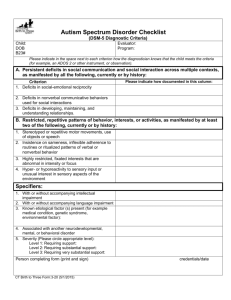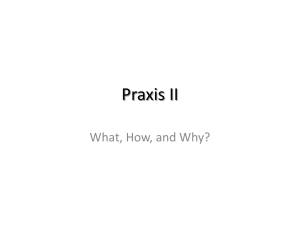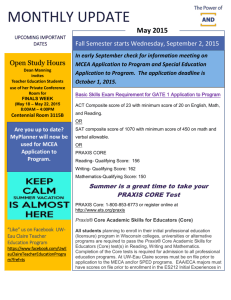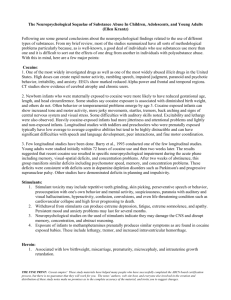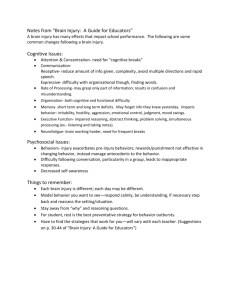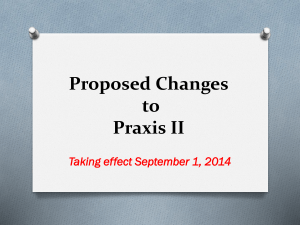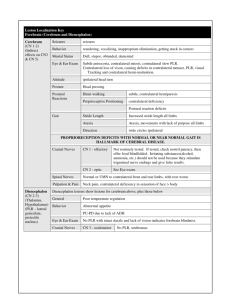Glossary of Pediatric OT Terms
advertisement
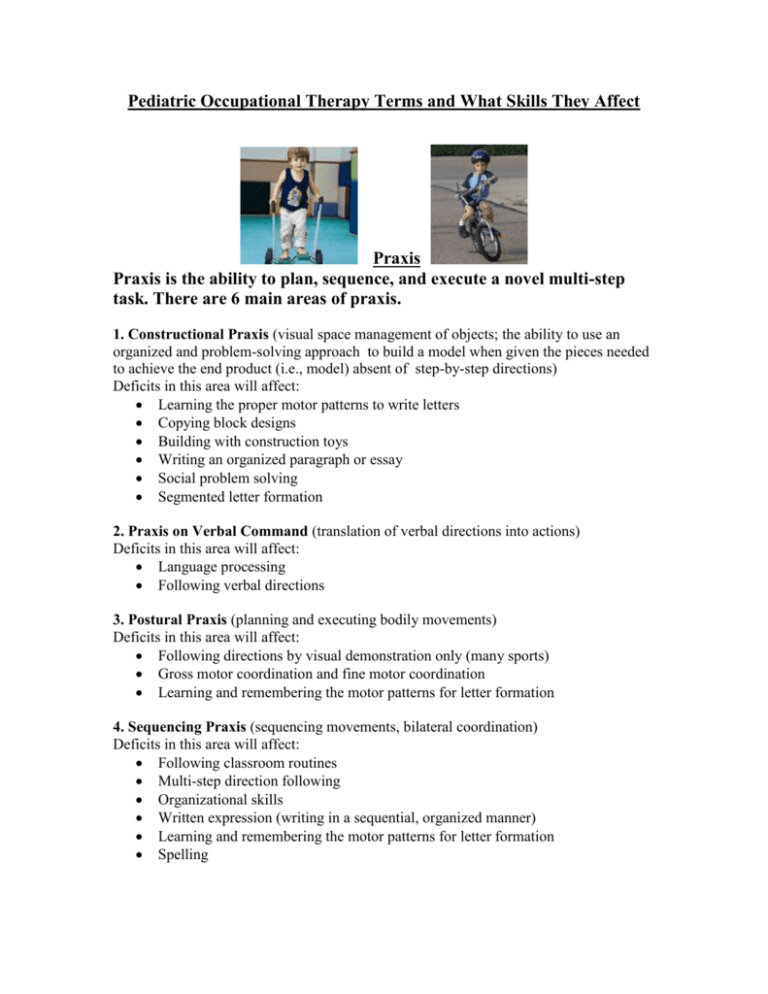
Pediatric Occupational Therapy Terms and What Skills They Affect Praxis Praxis is the ability to plan, sequence, and execute a novel multi-step task. There are 6 main areas of praxis. 1. Constructional Praxis (visual space management of objects; the ability to use an organized and problem-solving approach to build a model when given the pieces needed to achieve the end product (i.e., model) absent of step-by-step directions) Deficits in this area will affect: Learning the proper motor patterns to write letters Copying block designs Building with construction toys Writing an organized paragraph or essay Social problem solving Segmented letter formation 2. Praxis on Verbal Command (translation of verbal directions into actions) Deficits in this area will affect: Language processing Following verbal directions 3. Postural Praxis (planning and executing bodily movements) Deficits in this area will affect: Following directions by visual demonstration only (many sports) Gross motor coordination and fine motor coordination Learning and remembering the motor patterns for letter formation 4. Sequencing Praxis (sequencing movements, bilateral coordination) Deficits in this area will affect: Following classroom routines Multi-step direction following Organizational skills Written expression (writing in a sequential, organized manner) Learning and remembering the motor patterns for letter formation Spelling 5. Oral Praxis (speech skills and body awareness) Deficits in the area of oral praxis are related to speech skills; tongue, lip and jaw movements (eating); and overall body awareness as movements by mouth are completed without the use of vision. 6. Fluency (working with speed and accuracy, maintaining a consistent rhythm of movement) Deficits in this area will affect: Task initiation and completion Level of anxiety Social skills Reading fluency, writing fluency, math fluency Processing Speed Success with timed tasks Perform movements in a slow and plodding fashion Takes a long time to do most motor tasks Slow in dressing and eating Visual Perceptual Skills These skills are needed to understand, interpret and analyze what we see for reading and writing. There are 7 areas of visual perception. 1. Visual Discrimination (recognize differences and similarities between shapes, objects and patterns) Deficits in this area will affect: Letter alignment on lines Proofreading skills Distinguishing between similar letters r, n, h, b, d Distinguishing between math symbols and angles 2. Visual Closure (identify a picture or shape from a partially completed or disorganized presentation, including the ability to complete an incomplete drawing/letter/shape) Deficits in this area will affect: Spacing between letters and words Letter formation Breaking words into syllables Accurate copying from near and far without omitting information Fractions Reading fluency Completing a drawing or letter if given part of it Reading full test questions and stories for reading comprehension Visualizing end product when completing a construction activity 3. Visual Figure Ground (visually locate a picture, shape, letter or number among a busy, competing background) Deficits in this area will affect: Finding items in a desk or bookbag Keeping one’s place when copying from the board or a textbook Looking up words in a dictionary or on a map 4. Visual Spatial Relationships (recognize if a shape is facing a different direction from other shapes) Deficits in this area will affect: The ability to recognize letter and number reversals when reading and writing Graphing skills Lining up numbers in math Following a map or diagram Planning and organizing use of space on paper Right/left discrimination 5. Visual Form Constancy (recognize two shapes to be the same regardless of differences in size, shading, texture and/or position) Deficits in this area will affect: Distinguishing between similar forms such as an oval and circle or a square and rectangle Recognizing letters in various writing styles Projecting the idea of a shape onto something familiar (i.e., a snow cone is a triangle, a door is a rectangle) 6. Visual Memory (remember visual information, to recall or reproduce what is seen after viewing it for a short period of time) Deficits in this area will affect: Letter and number recognition Learning sight words Reproducing numbers, letters and shapes without looking at a model 7. Visual Sequential Memory (remember a sequence of pictures, shapes, letters, numbers. To recall or reproduce a sequence of visual information that is only seen for a short period of time) Deficits in this area will affect: Following multi-step directions Remembering the motor patterns for letter formation Spelling Copying from the board or a textbook Following classroom routines Remembering sequences (days of week, months, alphabet, phone numbers) Visual Motor Integration is the coordination of visual perceptual skills and hand/finger dexterity for writing and drawing. They are muscle movements guided by the eyes. Deficits will affect: Letter formation Drawing (pictures and shapes for geometry) Writing fluency (speed and accuracy) Reproducing drawings, letters, etc. from the board or a book Visual Motor Control is the ability to guide the hands with the eyes for skilled tool use. Deficits will affect: Coloring within boundaries Writing on lined paper Cutting along lines Ball skills Writing fluency (speed and accuracy) Bilateral Coordination is the ability to coordinate the two sides of the body to successfully and efficiently complete fine and gross motor tasks. Deficits will affect: Stabilizing the paper while writing Stabilizing and adjusting the paper while cutting Stabilizing a stencil or ruler while drawing along the edges Manipulating dressing fasteners (including tying shoes) Oculomotor Skills is the ability to quickly and accurately use the eyes together as a team. Deficits will affect: Attention Reading Writing Copying accuracy Visual endurance Perceptual motor skills Task accuracy and completion Losing place while reading, writing, copying May cause headaches
